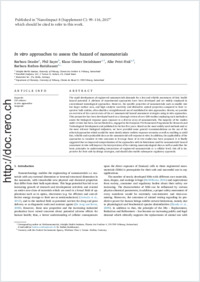In vitro approaches to assess the hazard of nanomaterials
- Drasler, Barbara Adolphe Merkle Institute, University of Fribourg, Switzerland
- Sayre, Phil NanoRisk Analytics, LLC, 5 Terrace Ct, Auburn, CA, United States
- Steinhäuser, Klaus Günter Brotteroder Str. 17a, Berlin, Germany
- Petri-Fink, Alke Adolphe Merkle Institute, University of Fribourg, Switzerland - Department of Chemistry, University of Fribourg, Switzerland
- Rothen-Rutishauser, Barbara Adolphe Merkle Institute, University of Fribourg, Switzerland
-
01.10.2017
Published in:
- NanoImpact. - 2017, vol. 8, no. Supplement C, p. 99–116
English
The rapid development of engineered nanomaterials demands for a fast and reliable assessment of their health hazard potential. A plethora of experimental approaches have been developed and are widely employed in conventional toxicological approaches. However, the specific properties of nanomaterials such as smaller size but larger surface area, and high catalytic reactivity and distinctive optical properties compared to their respective bulk entities, often disable a straightforward use of established in vitro approaches. Herein, we provide an overview of the current state-of the art nanomaterial hazard assessment strategies using in vitro approaches. This perspective has been developed based on a thorough review of over 200 studies employing such methods to assess the biological response upon exposure to a diverse array of nanomaterials. The majority of the studies under review has been, but not limited to, engaged in the European 7th Framework Programme for Research and Technological Development and published in the last five years. Based on the most widely used methods and/or the most relevant biological endpoints, we have provided some general recommendations on the use of the selected approaches which would the most closely mimic realistic exposure scenarios as well as enabling to yield fast, reliable and reproducible data on the nanomaterial-cell response in vitro. In addition, the applicability of the approaches to translate in vitro outcomes to leverage those of in vivo studies has been proposed. It is finally suggested that an improved comprehension of the approaches with its limitations used for nanomaterials' hazard assessment in vitro will improve the interpretation of the existing nanotoxicological data as well as underline the basic principles in understanding interactions of engineered nanomaterials at a cellular level; this all is imperative for their safe-by- design strategies, and should also enable subsequent regulatory approvals.
- Faculty
- Faculté des sciences et de médecine
- Department
- Département de Chimie
- Language
-
- English
- Classification
- Biological sciences
- License
- License undefined
- Identifiers
-
- RERO DOC 306231
- DOI 10.1016/j.impact.2017.08.002
- DOI 10.1016/j.impact.2017.10.002
- Persistent URL
- https://folia.unifr.ch/unifr/documents/306169
Statistics
Document views: 82
File downloads:
- fin_vaa.pdf: 300
